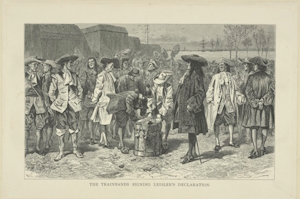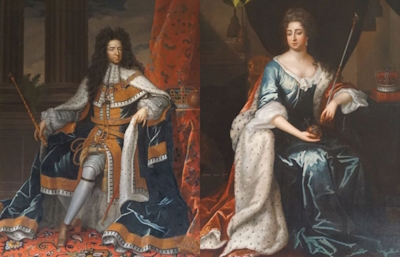 Leisler’s Rebellion took place in New York in 1689. New York had only become an English colony in 1664 during the reign of James II. It previously had the name New Amsterdam and was part of the Dutch colony New Netherlands. After the Director-General Peter Stuyvesant surrendered to English troops, the Dutch residents were permitted to remain in the colony and were granted religious freedom. The Dutch briefly regained the colony in 1673, but it became English again under the Treaty of Westminster, which ended the third Anglo-Dutch war. The governor of the colony of New York wasn’t keen to allow an elected representative assembly, instead letting it effectively be ruled by an oligarchy of wealthy merchants. In 1688 New York became a part of the Dominion of New England, governed by Sir Edmond Andros, who governed in an autocratically with no elected legislature.
Leisler’s Rebellion took place in New York in 1689. New York had only become an English colony in 1664 during the reign of James II. It previously had the name New Amsterdam and was part of the Dutch colony New Netherlands. After the Director-General Peter Stuyvesant surrendered to English troops, the Dutch residents were permitted to remain in the colony and were granted religious freedom. The Dutch briefly regained the colony in 1673, but it became English again under the Treaty of Westminster, which ended the third Anglo-Dutch war. The governor of the colony of New York wasn’t keen to allow an elected representative assembly, instead letting it effectively be ruled by an oligarchy of wealthy merchants. In 1688 New York became a part of the Dominion of New England, governed by Sir Edmond Andros, who governed in an autocratically with no elected legislature.
Tag: rebellions and revolts
Palmares
 In the early 17th century an autonomous, self-sufficient community of escaped slaves (maroons) known as Palmares established itself in the Captaincy of Pernambuco in north-eastern Brazil. It grew considerably throughout the 17th century, eventually becoming the largest settlement ever founded by runaway slaves in Brazil. Most of the information about this community comes from Portuguese and Dutch colonists and many of the names of those involved are unknown. At its apex, the population of Palmares reached somewhere between 10,000 and 20,000. The Palmaristas constantly resisted Portuguese and Dutch attacks while at the same time carrying out their own raids on the colonists. In the 1500s nearly half of all those enslaved from Africa were transported to Brazil, which was governed by the Portuguese at the time. Their settlements, called mocambos or quilombos, were constructed in the land’s interior, although the later is a modern term. At its height in the 1660s, Quilombo of Palmares was a confederation with a central capital and associated fortified towns and villages.…
In the early 17th century an autonomous, self-sufficient community of escaped slaves (maroons) known as Palmares established itself in the Captaincy of Pernambuco in north-eastern Brazil. It grew considerably throughout the 17th century, eventually becoming the largest settlement ever founded by runaway slaves in Brazil. Most of the information about this community comes from Portuguese and Dutch colonists and many of the names of those involved are unknown. At its apex, the population of Palmares reached somewhere between 10,000 and 20,000. The Palmaristas constantly resisted Portuguese and Dutch attacks while at the same time carrying out their own raids on the colonists. In the 1500s nearly half of all those enslaved from Africa were transported to Brazil, which was governed by the Portuguese at the time. Their settlements, called mocambos or quilombos, were constructed in the land’s interior, although the later is a modern term. At its height in the 1660s, Quilombo of Palmares was a confederation with a central capital and associated fortified towns and villages.…
The Glorious Revolution of 1688
 The ‘Glorious Revolution’, or de Glorieuze Overtocht in Dutch, is often called the Bloodless Revolution as there was very little bloodshed in England itself, although in Ireland it was a particularly bloody affair. Most ordinary people weren’t directly affected by the invasion as they had been during the Civil Wars (1642-52). In his book The King Over the Water, Desmond Steward said of it: “The events of 1688 were not so much a revolution as an aristocratic coup d’etat that ended in a one party state …” The events of 1688 were probably more significant politically for England than the Civil Wars as there were very few real changes to the system after the latter. Although William was invited to take the throne by some notable English figures, his arrival on British shores is still viewed by many as an invasion of England by the Dutch to remove a potential ally of Louis XIV of France.…
The ‘Glorious Revolution’, or de Glorieuze Overtocht in Dutch, is often called the Bloodless Revolution as there was very little bloodshed in England itself, although in Ireland it was a particularly bloody affair. Most ordinary people weren’t directly affected by the invasion as they had been during the Civil Wars (1642-52). In his book The King Over the Water, Desmond Steward said of it: “The events of 1688 were not so much a revolution as an aristocratic coup d’etat that ended in a one party state …” The events of 1688 were probably more significant politically for England than the Civil Wars as there were very few real changes to the system after the latter. Although William was invited to take the throne by some notable English figures, his arrival on British shores is still viewed by many as an invasion of England by the Dutch to remove a potential ally of Louis XIV of France.…
The maroons of Jamaica

Maroon was the name given to escaped African slaves and their descendants in the Caribbean. A large community began to flourish on the island of Jamaica, which was ruled by the Spanish at the time, from 1530 onwards after several slave revolts in the colonies of New Spain. The Spanish called them maroons, which is believed to come from the word ‘cimarron’, meaning ‘fierce’ or ‘unruly’. They were known to often ally themselves with buccaneers.
In 1655 the British conquered much of Jamaica and many slaves took advantage of the opportunity to join the maroon communities in the hills. At first, they fought the British, but later allied themselves with them against the Spanish under their leader Lubolo, finally driving the Spanish from the island in 1660. When Lubolo was later killed by another maroon leader called Juan de Serras in 1663, a war lasting decades broke out.
The British were unable to dislodge the maroons from their bases in the mountains, and in 1720 the maroons went on the offensive, attacking plantations.…
